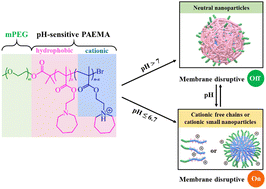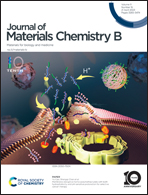Membrane-disruptive homo-polymethacrylate with both hydrophobicity and pH-sensitive protonation for selective cancer therapy
Abstract
The membrane-disruptive strategy, which involves host defense peptides and their mimetics, is a revolutionary cancer treatment based on broad-spectrum anticancer activities. However, clinical application is limited by low selectivity towards tumors. In this context, we have established a highly selective anticancer polymer, i.e. poly(ethylene glycol)-poly(2-azepane ethyl methacrylate) (PEG-PAEMA), that can mediate the membrane-disruptive activity via a subtle pH change between physiological pH and tumor acidity for selective cancer treatment. Specifically, the resulting PEG-PAEMA can assemble into neutral nanoparticles and silence the membrane-disruptive activity at physiological pH and disassemble into cationic free-chains or smaller nanoparticles with potent membrane-disruptive activity after the protonation of the PAEMA block due to tumor acidity, resulting in high selectivity towards tumors. Dramatically, PEG-PAEMA exhibited a >200-fold amplification in hemolysis and <5% in IC50 against Hepa1-6, SKOV3 and CT-26 cells at pH 6.7 as compared to those at pH 7.4, thanks to the selective membrane-disruptive mechanism. Moreover, mid- and high-dose PEG-PAEMA demonstrated higher anticancer efficacy than an optimal clinical prescription (bevacizumab plus PD-1) and, significantly, had few side effects on major organs in the tumor-bearing mice model, agreeing with the highly selective membrane-disruptive activity in vivo. Collectively, this work showcases the latent anticancer pharmacological activity of the PAEMA block, and also brings new hope for selective cancer therapy.

- This article is part of the themed collection: #MyFirstJMCB


 Please wait while we load your content...
Please wait while we load your content...